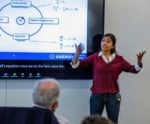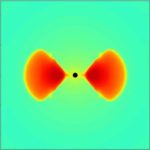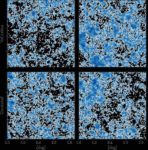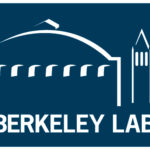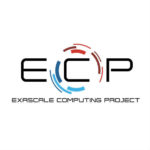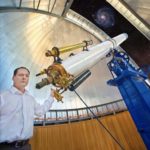Twenty-two postdoctoral fellows from across the Computing Sciences Area shared the status of their current projects at the first CSA Postdoc Symposium, held January 30-31 at Berkeley Lab. Their presentations covered a broad range of research topics, including code optimization, machine/deep learning, network routing, modeling and simulation of complex scientific problems, exascale, and other next-generation computer architectures.
Postdoc Symposium at Berkeley Lab Looks to Exascale for Modeling and Simulation
Supercomputing a Neutron Star Merger
Scientists are getting better at modeling the complex tangle of physics properties at play in one of the most powerful events in the known universe: the merger of two neutron stars. “We’re starting from a set of physical principles, carrying out a calculation that nobody has done at this level before, and then asking, ‘Are we reasonably close to observations or are we missing something important?’” said Rodrigo Fernández, a co-author of the latest study and a researcher at the University of Alberta.
Supercomputing Post-Wildfire Water Availability
A new study by scientists at Lawrence Berkeley National Laboratory (Berkeley Lab) uses a numerical model of an important watershed in California to shed light on how wildfires can affect large-scale hydrological processes, such as stream flow, groundwater levels, and snowpack and snowmelt. The team found that post-wildfire conditions resulted in greater winter snowpack and subsequently greater summer runoff as well as increased groundwater storage.
HPC Innovation Excellence Award Showcases Physics-based Scientific Discovery
A collaboration that includes researchers from NERSC was recently honored with an HPC Innovation Excellence Award for their work on “Physics-Based Unsupervised Discovery of Coherent Structures in Spatiotemporal Systems.” The award was presented in June by Hyperion Research during the ISC19 meeting in Frankfurt, Germany.
CosmoGAN Neural Network to Study Dark Matter
As cosmologists and astrophysicists delve deeper into the darkest recesses of the universe, their need for increasingly powerful observational and computational tools has expanded exponentially. From facilities such as the Dark Energy Spectroscopic Instrument to supercomputers like Lawrence Berkeley National Laboratory’s Cori system at NERSC, they are on a quest to collect, simulate, and analyze […]
Video: Simulations of Antarctic Meltdown should send chills on Earth Day
In this video, researchers investigate the millennial-scale vulnerability of the Antarctic Ice Sheet (AIS) due solely to the loss of its ice shelves. Starting at the present-day, the AIS evolves for 1000 years, exposing the floating ice shelves to an extreme thinning rate, which results in their complete collapse. The visualizations show the first 500 […]
Job of the Week: Computer Science Postdoctoral Scholar at Berkeley Lab
Berkeley Lab is seeking a Computer Science Postdoctoral Scholar in our Job of the Week. “Berkeley Lab’s Computational Research Division has an opening for a Computer Science Postdoctoral Scholar. Develop performance modeling and analytical capabilities and tools for manycore and GPU-accelerated supercomputers and apply them to distributed memory Office of Science applications running on such platforms.”
Berkeley Lab-led Collaborations win HPC Innovation Awards
Two Berkeley Lab-led projects—Celeste and Galactos—were honored with Hyperion Research’s 2017 HPC Innovation Excellence Awards for “the outstanding application of HPC for business and scientific achievements.” The HPC Innovation Excellence awards are designed to showcase return on investment and success stories involving HPC; to help other users better understand the benefits of adopting HPC; and to help justify HPC investments, including for small and medium-size enterprises.
Pagoda Project Rolls Out First Software Libraries for Exascale
The Pagoda Project—a three-year Exascale Computing Project software development program based at Lawrence Berkeley National Laboratory—has successfully reached a major milestone: making its open source software libraries publicly available as of September 30, 2017. “Our job is to ensure that the exascale applications reach key performance parameters defined by the DOE,” said Baden.
Video: Supercomputing Models Enable Detection of a Cosmic Cataclysm
In this podcast, Peter Nugent from Berkeley Lab explains how scientists confirmed the first-ever measurement of the merger of two neutron stars and its explosive aftermath. “Simulations succeeded in modeling what would happen in an incredibly complex phenomenon like a neutron star merger. Without the models, we all probably all would have been mystified by exactly what we were seeing in the sky.”

